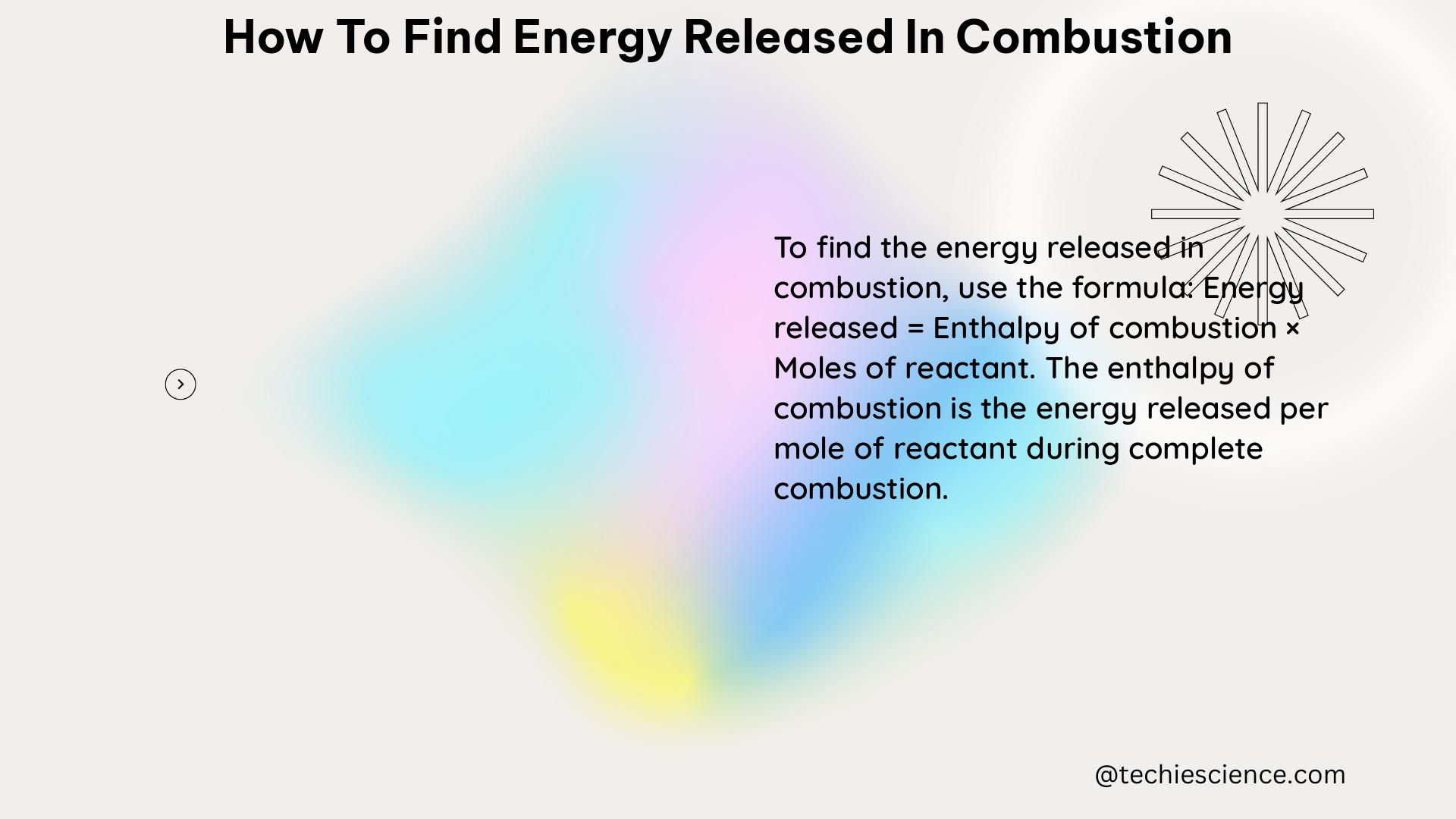The energy released during combustion is a crucial parameter in understanding the efficiency and environmental impact of various fuels. This comprehensive guide will delve into the detailed methods, formulas, and examples to help you accurately determine the energy released in combustion reactions.
Measurable Data and Formulas
1. Heat of Combustion
The heat of combustion, also known as the enthalpy of combustion, is the energy released per unit of fuel consumed during a combustion reaction. It is typically measured in kilojoules per mole (kJ/mol) or kilojoules per gram (kJ/g).
The heat of combustion can be calculated using the following formula:
(ΔH_c = -\frac{ΔE_c}{n})
Where:
– (ΔH_c) is the heat of combustion (kJ/mol)
– (ΔE_c) is the change in internal energy during the combustion reaction (kJ)
– (n) is the number of moles of the fuel consumed (mol)
The negative sign indicates that the reaction is exothermic, meaning energy is released during the combustion process.
Some examples of heat of combustion values:
– Hydrogen gas (H₂): 282 kJ/mol
– Methane (CH₄): -890 kJ/mol
– Propane (C₃H₈): -2,220 kJ/mol
– Octane (C₈H₁₈): -5,471 kJ/mol
2. Calorimetry
Calorimetry is a technique used to measure the heat involved in chemical or physical processes, including combustion reactions. The heat energy released can be calculated using the formula:
(Q = m \cdot c \cdot \Delta T)
Where:
– (Q) is the heat energy released (in kJ or kJ/mol)
– (m) is the mass of the substance (in kg or g)
– (c) is the specific heat capacity of the substance (in kJ/kg°C or kJ/g°C)
– (\Delta T) is the change in temperature (in °C)
The specific heat capacity of water is 4.18 kJ/kg°C, which is commonly used in calorimetry experiments.
3. Bomb Calorimeter
A bomb calorimeter is a specialized type of calorimeter designed to measure the energy produced by reactions that yield large amounts of heat and gaseous products, such as combustion reactions.
In a bomb calorimeter, the reaction takes place in a sealed steel bomb filled with the reactants and surrounded by a known mass of water. The temperature increase of the water is measured, and the energy released by the reaction can be calculated using the formula:
(Q = m \cdot c \cdot \Delta T)
Where:
– (Q) is the energy released by the reaction (in kJ or kJ/mol)
– (m) is the mass of the water (in kg or g)
– (c) is the specific heat capacity of water (4.18 kJ/kg°C)
– (\Delta T) is the change in temperature of the water (in °C)
The bomb calorimeter provides a more accurate measurement of the energy released during combustion compared to simple calorimetry experiments, as it can account for the energy released in the form of gaseous products.
Examples and Calculations

1. Calculating Heat Energy Released
Example: A spirit burner filled with ethanol (C₂H₅OH) is used to heat 200 cm³ of water. The temperature of the water rises from 22°C to 27°C.
Calculate the heat energy released:
(Q = m \cdot c \cdot \Delta T)
(= 0.2 \cdot 4.18 \cdot 5)
(= 4.18 \text{ kJ})
2. Heat of Combustion Calculations
Example: Calculate the energy released by four moles of hydrogen gas, given that one mole of hydrogen gas releases 282 kJ.
Energy released = 4 × 282 kJ = 1,128 kJ
3. Bomb Calorimeter Experiment
In a bomb calorimeter experiment, a 2.00 g sample of benzoic acid (C₆H₅COOH) is burned in pure oxygen. The temperature of the calorimeter increases from 22.50°C to 25.75°C. The mass of the water in the calorimeter is 2.00 kg.
Calculate the heat of combustion of benzoic acid.
Given:
– Mass of benzoic acid sample: 2.00 g
– Initial temperature: 22.50°C
– Final temperature: 25.75°C
– Mass of water in calorimeter: 2.00 kg
Using the formula:
(Q = m \cdot c \cdot \Delta T)
Substituting the values:
(Q = 2.00 \cdot 4.18 \cdot (25.75 – 22.50))
(Q = 2.00 \cdot 4.18 \cdot 3.25)
(Q = 27.17 \text{ kJ})
The heat of combustion of benzoic acid can be calculated as:
(ΔH_c = -\frac{Q}{m} = -\frac{27.17 \text{ kJ}}{2.00 \text{ g}} = -13.585 \text{ kJ/g})
Additional Resources and References
-
Stack Exchange – Earth Science: Discussion on the measurable impact of energy released from burning fossil fuels on global warming
-
Thermochemistry: Chapter on thermochemistry, including the basics of energy, heat, and temperature, as well as calculations involving heat and specific heat
-
BBC Bitesize: Guide on calculating the energy released when fuels burn, including the formula (Q = m \cdot c \cdot \Delta T)
-
YouTube – Combustion Reactions: Video explaining combustion reactions and how to calculate the energy released from burning fuels
-
Lumen Learning – Calorimetry: Chapter on calorimetry, including the technique, examples, and calculations involving heat flow

The lambdageeks.com Core SME Team is a group of experienced subject matter experts from diverse scientific and technical fields including Physics, Chemistry, Technology,Electronics & Electrical Engineering, Automotive, Mechanical Engineering. Our team collaborates to create high-quality, well-researched articles on a wide range of science and technology topics for the lambdageeks.com website.
All Our Senior SME are having more than 7 Years of experience in the respective fields . They are either Working Industry Professionals or assocaited With different Universities. Refer Our Authors Page to get to know About our Core SMEs.